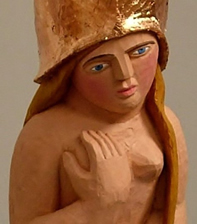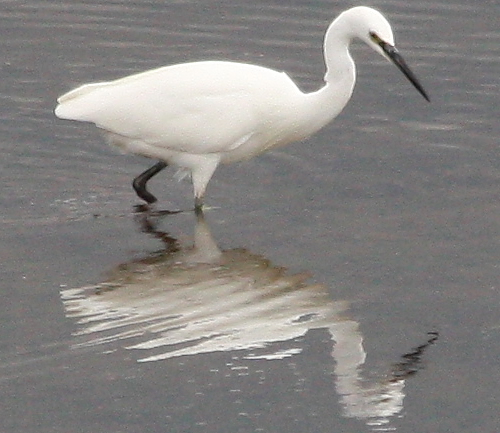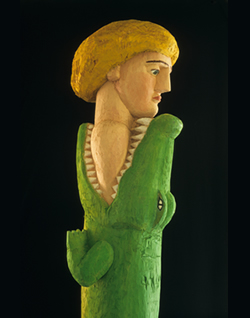SCIENCE
Artists and scientists are similar inasmuch as they both attempt to describe and to understand the world. Although I consider myself to be primarily an artist, I am also interested in science which is reflected in my art practice. However, some of my interests are more appropriately pursued through a direct engagement with science and participation in scientific activities.
Pain Relief During Mammography Available, but not Used by UK NHS

Amazon with Lizard (detail)
By Christine Kowal Post
It seems that 35-45% of women report pain suffered during mammography (mid-range of various studies) and for some women this is not merely an unfortunate discomfort – it is an agony which is anticipated with dread. In Japan there are even reports of women fainting, but when I lived in the Netherlands (during the 1990s) the radiographers routinely used thin foam pads called breast cushions to reduce pain. Breast cushions are almost completely unused in UK. In my experience, clinicians and radiographers seem to be ignorant of their existence, but scientific surveys have indicated that in UK an estimated 47,000 to 87,0000 women per year do not come back for mammograms because of pain, and other scientific studies have indicated that breast cushions reduce this pain by 50%. These cushions have been available for at least twenty years and the level of ignorance and denial in the UK medical profession beggars belief. The ones available in UK are called 'MammoPads', but as far as I can tell the only hospital that uses them for pain reduction is the Countess of Chester Hospital.
Using my review, Baroness Massey asked a question in the House of Lords (19th November 2018), and as a result of her action the Department of Health has promised to review the situation. You can read an article she has written for PoliticsHome by following this link:
https://www.politicshome.com/news/uk/health-and-care/illnesstreatments/opinion/house-lords/99919/baroness-massey-women-have-right
Babies versus beasts - A Letter to New Scientist


Atylotus rusticus
Copyright Malcolm Storey
One of my art subjects is the nature of the body, our relationship with it and its antagonists (see Corporeal Insults). So when I saw some unusual horseflies biting a horse in the field next to my studio I captured them. They turned out to be a rare species listed in the British Red Data Book for Insects and the four specimens I collected had doubled the number found in England in the last hundred years. The next time I caught one a few days later I let it go, and it immediately flew over to bite the horse. There was clearly a dilemma between the conservation status of the fly and the well-being of the horse. I collaborated with entomologists from The Natural History Museum to record this finding:
Storey MW, Post RJ, Kowal Post C & Chainey J (2006) Recent records of Atylotus rusticus (Diptera, Tabanidae). Dipterists Digest13, 21-22.
Little Egret
Copyright Frank Boxell
My recent work (see They think they are Fallen Angels) concerns how we see our place in the natural world. Darwin published On the Origin of Species and The Descent of Man over 100 years ago in the 19 th century but we humans seem to be reluctant to accept our animal nature. You can see this in the way we continuously try to find ways of placing ourselves apart from other animals. We try to find ways in which humans are unique or special by invoking our creativity, consciousness and tool use for example. When I saw a Little Egret in Kenya using bait for fishing I realised this behaviour was tantamount to tool use and indicated cognitive mind abilities. I had been feeding fish in an ornamental lake when a Little Egret flew over from the other side of the lake. I tossed it a piece of bread but instead of eating it, the bird picked it up in its beak, walked to the edge of the lake, dropped it in the water and waited to catch the fish that were attracted to feed. This was the first record of bait fishing in Little Egrets, and only the eleventh species of bird recorded to have this ability. I published this finding in collaboration with two biologists:
Post RJ, Kowal Post CP & Walsh JF (2009) Little Egret (Egretta garzetta) and Grey Heron (Ardea cinerea) using bait for fishing in Kenya. Waterbirds 32, 450-452.

Woman Being Eaten by a Crocodile
by Christine Kowal Post
From Christine Kowal Post
So Stellan Welin, a bioethicist, thinks the ethical questions posed by eating meat from rare and unusual species can be “sidestepped” with meat grown from stem cells. There still seems something unpleasant about shifting our view of these animals towards a source of food rather than as companions on the same planet. Talking of companions, I was surprised Welin did not mention any similar enthusiasm for eating manufactured human flesh. I am sure there would be a market.
http://www.newscientist.com/article/mg21128300.100-human-hotpot.html